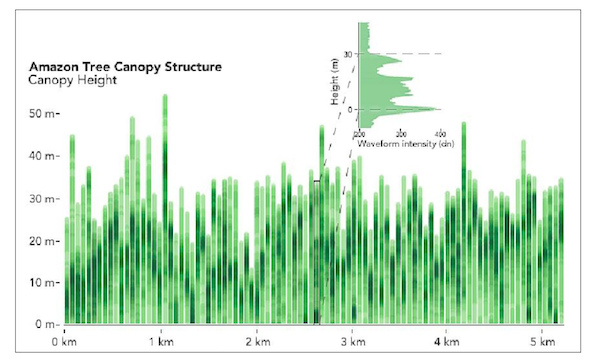SEJournal Online is the digital news magazine of the Society of Environmental Journalists. Learn more about SEJournal Online, including submission, subscription and advertising information.
 |
| Waveforms gathered by the Space Station’s GEDI instruments are collected together to show forest structure. Above, a section of the Amazon rainforest. Image: NASA Earth Observatory/Lauren Dauphin. |
Reporter’s Toolbox: NASA Set To Ditch Satellite-Based Environmental Data Source
By Joseph A. Davis
If your computer has ever crashed holding an almost-finished story, you know what it is to lose data. NASA is about to do much the same, deliberately jettisoning an instrument on the International Space Station that gathers data about the environment.
The Global Ecosystem Dynamics Investigation, or GEDI, uses lidar to produce 3-D images of forest canopies and other terrestrial features. Lidar is a kind of remote sensing radar that uses reflected light instead of radar waves, bouncing pulses of near-infrared light 242 times per second to capture reflections that form the images.
Among its other capabilities, GEDI is also expert at
estimating the carbon content of ecosystems —
something both journalists and scientists care about.
Among its other capabilities, it is also expert at estimating the carbon content of ecosystems — something both journalists and scientists care about.
But NASA plans to detach GEDI from the space station and let it burn up in the atmosphere. Scientists are lobbying, along with some elected officials, to save it. Their plea: GEDI is not finished mapping all the areas it can.
Meanwhile, the data is available to the public and downloadable. So for the moment, it appears to be the sad tale of data everywhere: Use it or lose it.
Where the data come from
Because Lidar has many other applications, the GEDI instrument allows a much deeper understanding of carbon and water cycling, key to a better understanding of global heating.
The orbiting instrument also contains a scanner and a GPS system to get precise location information.
The research team working on GEDI spans many agencies and university research centers but is centered at NASA’s Goddard Space Flight Center and the University of Maryland. That might help explain why one of the biggest lobbyists for letting it finish its mission is Maryland’s Democratic senator, Chris Van Hollen.
How to use the data smartly
Most journalists are not equipped to use GEDI data for routine reporting. But environmental journalists still should be curious about local forests and landforms that affect climate — or are affected by it. How much carbon do they contain? Are they storing it or releasing it?
The answer is to seek out those who know or use GEDI data. Find experts and researchers in your area who may be studying the carbon consequences of forests near you. They can help you read the numbers.
Another strategy is to approach the data as only part of the story. What really matters is what is happening to the planet.
Also, remember how much other ecosystem data may be available via other data sources.
Be aware of data tools such as Landsat (currently in its ninth reincarnation). Or SkyTruth, which applies a variety of geodata to environmental issues such as spills.
[Editor’s Note: Find more on satellite-based tools elsewhere in Reporter’s Toolbox, such as pieces on the Landsat 9 satellite and on ship trackers. Also see a feature story on how satellites capture tension over food production and biodiversity, an Inside Story Q&A on how one reporter used satellite data to track Amazonian wildfires and a special report on Covering Climate Solutions that notes how satellites are being used to trace global methane emissions.]
Joseph A. Davis is a freelance writer/editor in Washington, D.C. who has been writing about the environment since 1976. He writes SEJournal Online's TipSheet, Reporter's Toolbox and Issue Backgrounder, and curates SEJ's weekday news headlines service EJToday and @EJTodayNews. Davis also directs SEJ's Freedom of Information Project and writes the WatchDog opinion column.
* From the weekly news magazine SEJournal Online, Vol. 8, No. 2. Content from each new issue of SEJournal Online is available to the public via the SEJournal Online main page. Subscribe to the e-newsletter here. And see past issues of the SEJournal archived here.













 Advertisement
Advertisement 



